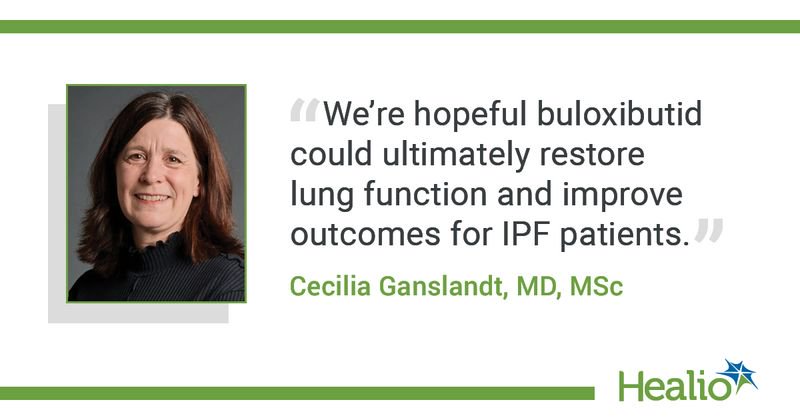Buloxibutid well tolerated, increases lung function in IPF
Key takeaways:
- Few patients with IPF reported gastrointestinal side effects during buloxibutid treatment.
- Planned future research will assess buloxibutid over 52 weeks.
SAN DIEGO — Among patients with idiopathic pulmonary fibrosis, twice-daily buloxibutid for 36 weeks significantly improved FVC, according to research presented at the American Thoracic Society International Conference.
Buloxibutid (Vicore Pharma), “an oral, selective angiotensin II type 2 receptor agonist,” was also not linked to any serious/severe adverse events, according to researchers.

“These findings represent that we have a potentially disease modifying therapy that could turn a fatal disease into a treatable one,” Cecilia Ganslandt, MD, MSc, global medical director at Vicore Pharma, told Healio.
“Based on these findings, we’re hopeful buloxibutid could ultimately restore lung function and improve outcomes for IPF patients,” she added.
In the multicenter, international, open-label, single-arm phase 2a AIR trial, Ganslandt and colleagues assessed 52 patients (mean age, 67.3 years; 77% men; 73% Asian; 27% white; mean BMI, 24.6 kg/m2) with IPF who had not received treatment to determine whether twice-daily 100 mg buloxibutid for 36 weeks is safe and how it impacts FVC over time.
The safety analysis included all 52 patients, and the efficacy analysis included 50 patients despite only 28 patients having data for the full treatment period.
The most common reason for no 36-week data was patient decision (n = 14), followed by an adverse event (n = 5), FVC decline (n = 3) and death (n = 2). Researchers noted that 17% of discontinuations took place after week 12.
Among the 37 patients (71.2%) who experienced a treatment-emergent adverse event, 10 (19.2%) had an event related to buloxibutid. In contrast, buloxibutid was not found to be related to any of the treatment-emergent adverse events classified as serious (n = 5), severe (n = 3) or fatal (n = 2).
Mild to moderate, reversible hair loss was indicated by 10 patients (19.2%), whereas fewer patients reported rash, cough, gastroesophageal reflux disease, increased blood creatinine and pyrexia (each, n = 4; 7.7%).
“The findings indicate that buloxibutid does not carry the debilitating gastrointestinal side effects observed with current standard of care, which may promote treatment persistence and better long-term outcomes,” Ganslandt said.
Mean FVC at baseline was 75.5% predicted, and instead of going down, FVC significantly increased in the treated patient population at week 28 (P < .01), week 32 (P < .001) and week 36 (P < .001).
“The ability to improve lung function as measured by FVC over the 36-week study and the excellent safety and tolerability profile of our drug candidate for IPF, buloxibutid, were very exciting for us to see,” Ganslandt told Healio.
Researchers also observed significant improvements in baseline plasma matrix metalloproteinase-13 (fibrolytic activity biomarker) at week 12 (P < .01), week 24 (P < .001) and week 36 (P < .01) of buloxibutid treatment.
Lastly, although not statistically significant, there was a trend of reductions in baseline plasma transforming growth factor beta 1 (fibrosis biomarker) over the 36-week treatment period.
“Buloxibutid has a unique upstream mechanism as suggested by nonclinical research and biomarker data, but the magnitude of the treatment effect was even beyond our initial expectations,” Ganslandt said.
Looking ahead, the ASPIRE trial will continue to study buloxibutid use in patients with IPF over 52 weeks.
“Our next phase 2b ASPIRE study will be larger, placebo-controlled, include standard of care, measure lung function and patient-reported outcomes for 1 year and include multiple doses of our therapy,” Ganslandt told Healio. “We have also included patients and caregivers in the design of the study to optimize the participant experience and increase the attractiveness of joining.
“This will be an important step in our mission of having a meaningful impact on the future treatment outcomes for IPF patients,” she added.

